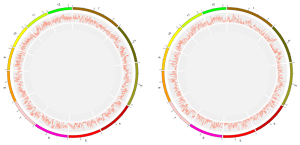CUHK
News Centre
Genetic identification to preserve local heirloom rice varieties and facilitate their reintroduction in Hong Kong
The Hong Kong Seed Technology and Education Center (SeedTEC) at The Chinese University of Hong Kong (CUHK) has collaborated with the Agriculture, Fisheries and Conservation Department (AFCD) on a project to reintroduce local heirloom rice varieties to local farmers. Using novel genomic sequencing technology and molecular markers, CUHK researchers generated a “genetic ID” for “Fa Yiu Tsai” and “See Mew”, allowing the authenticity of the varieties to be identified.
Hong Kong rice was sold overseas and given as tribute to royalty
Rice cultivation once flourished in Hong Kong’s New Territories. During the Song Dynasty, walled villages and farming culture evolved in the New Territories. Famous rice varieties were not only exported to Southeast Asia and the United States but were also given as tribute to Qing Dynasty royalty.
According to early government reports such as the Gazetteer of Xin’an County in 1688 and a report by Mr. Stewart Lockhart, Colonial Secretary of Hong Kong in 1898, showed that rice was the primary crop cultivated in the New Territories. Farmers who used to grow rice in the Yuen Long and Kam Tin areas carried hundreds of catties of rice every day to Tsuen Wan for sale. The path is now known as the Yuen Tsuen Ancient Trail.
In 1954, the area of Hong Kong’s paddy fields reached 9,466 hectares, and yielding 20,000 tons of rice annually. But with economic transformation, an increase in rice imports, an exodus of indigenous inhabitants and the urbanisation of rural areas, rice cultivation almost disappeared in Hong Kong. At present, Hong Kong consumes 3.3 kg of rice per capita per month and almost entirely relies on imports. There are only about 10 rice farms in Hong Kong, with a total estimated cultivation area of 2.7 hectares.
Genetic identification to preserve native rice varieties
The CUHK research team supported the AFCD’s effort in restoring local rice cultivation by applying bioinformatics analysis on “Fa Yiu Tsai” and “See Mew” seeds to make sure they were not genetically polluted. They inspected the raw genomic data and found that the genomic sequences of both varieties resemble their mother generation after rounds of propagation (with over 98% genetic homogeneity), indicating that the purity of “Fa Yiu Tsai” and “See Mew” has been preserved during propagation.
The team also compared the genomic data of “Fa Yiu Tsai” and “See Mew” with the published genome resequencing data of more than 3,000 rice varieties. They discovered unique DNA markers of “Fa Yiu Tsai” and “See Mew” and generated a “genetic ID card” for both to identify their authenticity.
Project leader Professor Lam Hon-Ming, Choh-Ming Li Professor of Life Sciences and Director of the State Key Laboratory of Agrobiotechnology (CUHK), hopes that the project will help improve agricultural standards and promote the restoration of farming in Hong Kong. “Agriculture constitutes an important part of our history and culture. Our team has used new technologies to identify Hong Kong’s traditional rice and restore some missing pieces of Hong Kong history and a legacy through the seeds left to new generation famers. The project helps create public awareness of conservation and social belonging,” said Professor Lam.
Ms. Mon Wong, Agricultural Officer of the AFCD said that to facilitate reintroduction of rice by the younger generation, the department obtained four rice varieties that were once popular in Hong Kong from the seed bank in 2019: “Fa Yiu Tsai”, “See Mew”, “Chai Mei” and “Pak Huk Chai Mei”. Conservation and cultivation of these varieties is conducted at the AFCD’s Tai Lung Experimental Station. After propagating them for generations in a greenhouse, the department has delivered the self-cultivated seeds and the original seeds to the SeedTEC to test for their genetic consistency.
As the growth and seed purity of “Fa Yiu Tsai” were judged stable, Ms. Wong said that the AFCD has passed “Fa Yiu Tsai” seeds onto local farmers so they could run trials of planting them. To promote cultivation of local heirloom rice varieties, the AFCD also held a cultivation seminar and provided technical support to the local farmers. She commended that CUHK’s collaboration with the AFCD to promote the reintroduction of local heirloom rice varieties in Hong Kong has been highly synergistic.
This collaboration over rice restoration not only demonstrates how new technologies can be of benefit to society, but can also serve as teaching material for STEM education.
About the Hong Kong Seed Technology and Education Center, The Chinese University of Hong Kong (CUHK)
The Hong Kong Seed Technology and Education Centre funded by the Sustainable Agriculture Development Fund of the Agriculture, Fisheries and Conservation Department, was established in July 2020 and is directed by Professor Lam Hon-Ming of CUHK.
The center aims to support Hong Kong agriculture transiting to modernisation, improve the technical level of seed quality testing, encourage local farmers to cultivate high-quality seeds, promote agricultural education and conservation, and promote the restoration of local farming in Hong Kong.
The center’s website: https://www.seedtec.hk/

The CUHK team conducted genomic analysis on the raw genome data of Hong Kong rice varitety “Fa Yiu Tsai” and “See Mew” provided by the AFCD to reveal their genomic identity.
Project leader Professor Lam Hon-Ming, Choh-Ming Li Professor of Life Sciences and Director of the State Key Laboratory of Agrobiotechnology (CUHK) (left) and Ms. Mon Wong, Agricultural Officer of the AFCD (right).










